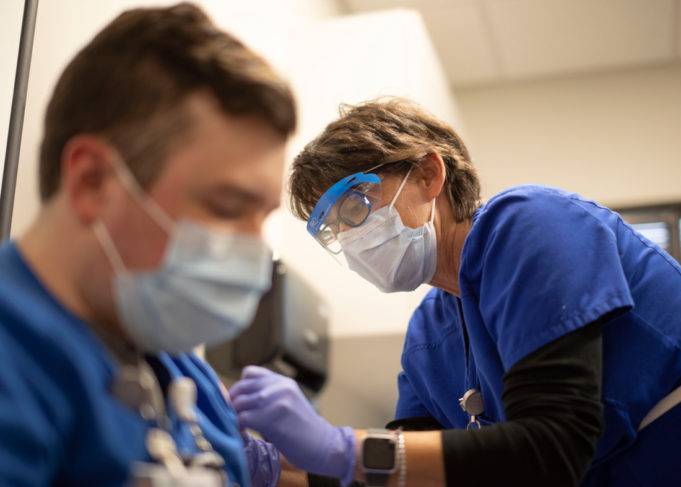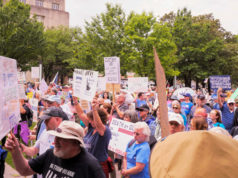Wednesday’s COVID-19 vaccine felt like “hope in a bottle,” said Dr. Kerim Razack, partner with Texas Pulmonary & Critical Care Consultants at Texas Health Southwest. As one of three critical care doctors at his southwest Fort Worth hospital, Dr. Razack has worked six weeks straight. Since March, he estimates that his critical care team has seen upwards of 100 local residents die from COVID-19, often after struggling for up to several weeks on ventilators.
Hospitalized patients are now treated with steroids, convalescent plasma (taken from patients who have recovered from COVID-19), and the antiviral treatment remdesivir, he said. Patients who continue to decline are placed on ventilators as a last resort.
“If we are putting someone on a ventilator, they are extremely sick,” Dr. Razack said. “If you are bad enough to need the ventilator, your chances of dying are 90 to 95%. That’s why the mood in the ICU is so grim. Everybody knows that as soon as this patient ends up on the ventilator, in two, three, or six weeks, they will likely die from this. If they survive, it could take months to learn how to walk and eat again.”
Given the high mortality rate, some severely ill patients are declining to be placed on life support to avoid prolonging death once the disease has reached advanced stages, he added.
After nine months of treating patients for a disease that has claimed the lives of 319,000 Americans, Dr. Razack sees the COVID-19 vaccine rollout as the “beginning of the end” to the worst pandemic the world has seen in a century. The physician said he felt no symptoms for several hours after receiving the Pfizer vaccine.
“At about eight hours, my arm was a little sore, and I felt a little achy, kinda like when you are starting to get the flu,” he said. The next morning, “I woke up feeling fine.”
Last week, 5,850 doses of the COVID-19 vaccine arrived at Texas Health Resources’ central pharmacy. As of Monday, the network of 28 hospitals has more than 6,400 doses of the vaccine, including more than 500 at its southwest Fort Worth location, a Texas Health Resources spokesperson said. Small boxes containing the inoculations are stored at -94 degrees Fahrenheit as required by the manufacturer. Before shots are administered, the vaccine must be thawed and then diluted, the spokesperson said.
Barclay Berdan, Texas Health CEO, said his “team members are exhausted from nine months of providing intensive care to seriously ill patients with COVID-19, but despite that weariness, [Texas Health frontline workers] continue to care for patients and their families each day. The vaccine will help protect [the workers] as they continue to serve the people in our communities.”
On December 11, the Food and Drug Administration (FDA) issued the first emergency use authorization for the Pfizer COVID-19 vaccine. FDA Commissioner Stephen Hahn said the authorization “follows an open and transparent review process that included input from independent scientific and public health experts and a thorough evaluation by the agency’s career scientists to ensure this vaccine met FDA’s rigorous, scientific standards for safety, effectiveness, and manufacturing quality needed to support emergency use authorization.”
The Texas Department of State Health Services (DSHS) said 224,250 doses were released to 110 providers across the state as part of last week’s initial vaccine distribution effort. This week, DSHS said in a public statement that “620,400 doses of COVID-19 vaccine [were] distributed to more than 1,100 providers in 185 Texas counties in Week 2 of vaccine distribution. The [Centers for Disease Control and Prevention] will deliver 460,500 doses of the vaccine manufactured by Moderna and 159,900 doses of the Pfizer vaccine to continue to vaccinate frontline health care workers and residents of long-term care facilities.”
The FDA approved the Moderna vaccine on Friday, making the vaccine the second to see mass distribution in the United States. Unlike the Pfizer vaccine, Moderna’s preventative treatments can be stored in normal freezers, which will allow for easier distribution to rural areas in Texas.
The arrival of the first batches of vaccines comes at a time when North Texas and the state are experiencing a surge in COVID-19 infections and deaths. Texas now has 1,413,684 confirmed COVID-19 cases, according to DSHS. Tarrant County has 114,617 confirmed cases and 1,276 COVID-19-related deaths.
As of Monday, 2,000 frontline workers received COVID-19 vaccines at Cook Children’s, a hospital spokesperson said. The initial recipients included “doctors and nurses who work with COVID-19 patients as well as employees who may be in close contact with patients and families such as environmental service workers, members of Cook Children’s Teddy Bear Transport Team, security, lab, and food and nutrition employees.”
The day was “emotional,” said Debbie Boudreaux, assistant vice president of nursing at Cook Children’s, “because we’ve waited so long for this pandemic to end. This has been a team effort from the very beginning, with our COVID-19 Command Center working tirelessly to adapt to all the changes we’ve had to make to keep our employees, patients, and families safe.”
Jason Reese, a respiratory therapist at Cook Children’s, said he took the vaccine for personal and medical reasons.
“The reason why I’m taking the vaccine today is because my step-dad passed away last week from COVID complications, and it is super-important to me, to my family, and to the community to get this vaccine,” he said.
A spokesperson for Medical City Fort Worth said the 320-bed facility recently received vaccines. Medical City, which has 184 hospitals in the United States and England, received 6,825 vaccines Thursday and thousands more are expected “in coming days.”
Brian Murnahan, a spokesperson for Tarrant County Public Health, said TCPH has not received COVID-19 vaccines because the treatments are going to frontline health care workers, meaning hospitals are prioritized over government agencies. DSHS allocation principles outline state priorities for vaccine administration, he said. Health care workers, particularly those on the front lines, are prioritized. Residents of long-term care facilities and hospice workers are also included in the state’s first phase of vaccine rollouts.
In light of the ongoing vaccination efforts, Dr. Anthony Fauci, the nation’s go-to official on infectious diseases, said the United States could see the early stages of herd immunity by as early as late spring. Gov. Greg Abbott said Texans can expect to see widespread distribution of the COVID-19 vaccine by March.












